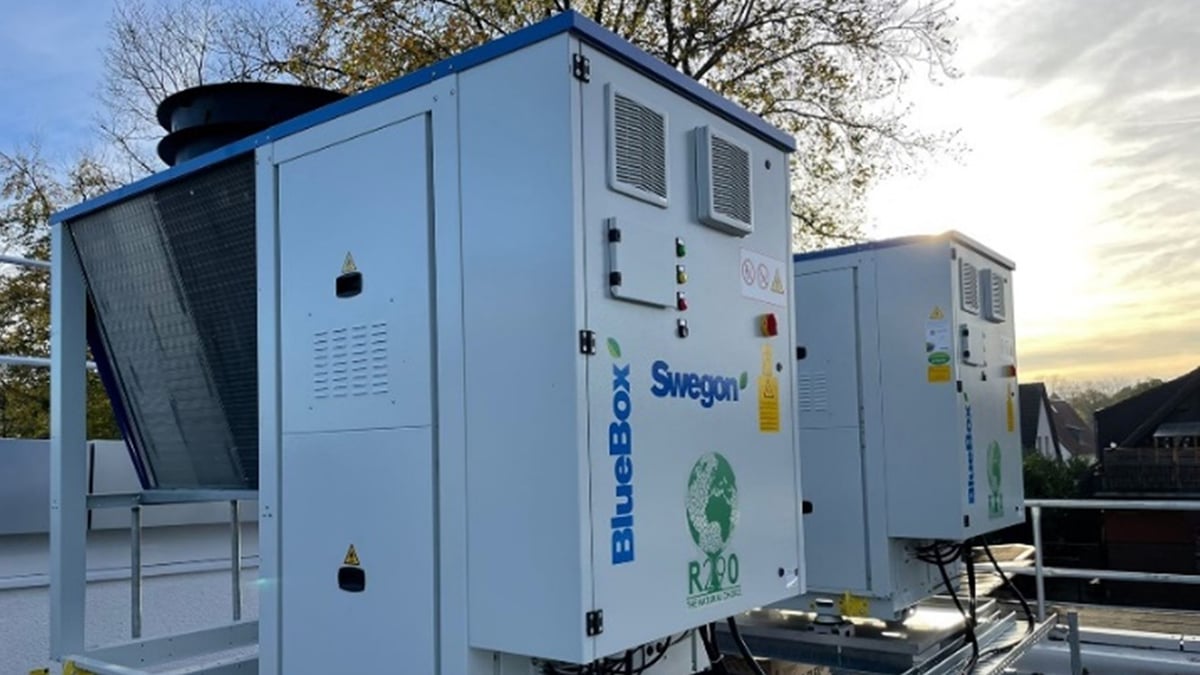New supermarket buildings are now conceived as a holistic energy concept, for example, by using the waste heat generated during commercial refrigeration for building heating or domestic water heating. However, even in the renovation of grocery stores, there are various modernisation measures that offer savings potential with an existing heat recovery system.
One example is the energy-efficient renovation of a supermarket in Mainz. This 1,400 m² supermarket was selected by a major grocery chain as a model store to test a renovation concept using heat pumps. This concept was implemented in 2022 and has since been applied in two other stores within the chain. Other supermarkets are following suit throughout Germany.
Current conditions and the challenge: Renovation of a 1,400 m² grocery store in Mainz
The previous heating and cooling concept of the food market included a hot and cold water supply, which was connected to the commercial refrigeration system via interfaces.
Challenge: Heating operation
During heating operation, the waste heat from the commercial refrigeration system was transferred to a buffer storage tank via a plate heat exchanger. This waste heat was sufficient to adequately heat the store during the heating season. However, bottlenecks in the heat supply arose when the heat recovery capacity was insufficient or non-existent. The reason for this was that there was no peak load coverage for heavy load cases.
Challenge: Air conditioning of the sales area
For cooling purposes, there was also an interface to the commercial refrigeration system via plate heat exchangers. In the summer, the buffer tank was filled with cold water for cooling. The challenge at this grocery store lay in air conditioning the sales area via the commercial refrigeration system. This did not meet the refrigeration requirements of a modern refrigeration system. And this needed to be changed.
Goals and objectives for the renovation of the supermarket
Through energy-saving modernisation measures, this model grocery store was intended to:
- Utilise the waste heat generated during commercial refrigeration for building heating and domestic water heating
- Leverage further savings potential through the implementation of a heat recovery system
- Increase operational reliability
The following requirements had to be considered during the renovation of the 1,400 m² supermarket:
- Year-round provision of hot and cold water
- Use of the environmentally friendly refrigerant R290 (propane)
- Low CO2 emissions
- Eligibility for heat pumps
- Minimal modification of the existing hydraulic system (continued use of the existing buffer tank for hot or cold water)
- High energy efficiency
- Complete solution, including autonomous control system
Renovation of the food market: The technical implementation
Swegon developed a customised concept for this supermarket, which was integrated into the existing system to ensure year-round hot and cold water supply. Eligible heat pumps filled with the environmentally friendly and natural refrigerant propane (R290) and featuring intelligent control technology were used.
Heat pumps as master and slave units with HYZER control
To achieve high energy efficiency, two Titan Sky Hi HP R0 5.1 heat pumps from Swegon were combined as master and slave units, which communicate with each other using the system-optimised HYZER control system.

Two Titan Sky Hi HP RO 5.1 from BlueBox - Master and Slave
This control system enables intelligent cascade switching. This means that the heat pumps can be operated either individually or in parallel, depending on the load. This ensures that the heat pumps are always used in their optimal operating range. The HYZER control system also optimises the defrosting of the heat pump. Because defrosting only occurs when needed, defrosting frequencies are significantly reduced, while simultaneously increasing the efficiency of the heat pump and the comfort in the sales area. To put this in concrete terms: if the defrost function is requested from one of the two installed heat pumps, the second heat pump starts up in return to prevent losses in comfort, such as a room temperature that is too low or too high.

Concept diagram: Master and Slave Heat pumps - combination with variable volume flow control by HYZER
The aforementioned cascade control ensures automated fault, redundancy and time-based switching of the heat pumps. What's special about the HYZER system is that it also optimises hydraulic control: various sensors are combined with calculation algorithms, and together they monitor the heating or cooling power consumed by the building. Based on these results, the HYZER system regulates both the power output of the heat pumps and the volume flows in the hydraulic system – all according to demand. This minimises the electrical power consumption of the integrated components, such as heat or circulation pumps. Furthermore, energy consumption is recorded in real time, enabling structured data analysis of energy savings.
HYZER: The regulation for various project requirements
The HYZER control unit has a modular design, making it suitable for a variety of project requirements (size, complexity, applications) and can be customised to the customer's needs. In the case of the Mainz grocery store, Swegon supplied a standalone control system with clearly defined interfaces to the building management system. This allowed the store's existing hydraulic system to be largely retained. Only a hydraulic separator was integrated to decouple the primary and secondary circuits as an efficiency-enhancing addition. Heat distribution via secondary recirculation units, door air curtains and static heating surfaces also remained unchanged.

HYZER control unit shown schematically
Finally, the heat pump cascade, including variable flow rate control, is self-sufficient. This means the system can also be used in larger projects. It is capable of managing additional external devices, such as dry coolers, cooling towers, peak load boilers and the control of the consumer side.

























.jpg?width=75&name=Image%20(5).jpg)








.jpg?width=75&name=magnus%20andersson_550x550%20(1).jpg)











.jpg?width=75&name=0%20(1).jpg)





-4.png?width=75&name=MicrosoftTeams-image%20(3)-4.png)














